|

Summer 2001 (9.2)
Pages
32-34
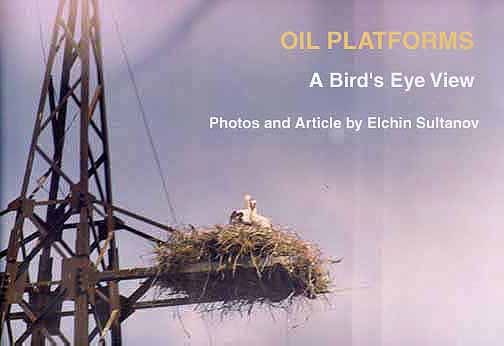
Above:
Azerbaijan's
abandoned oil platforms provide nesting areas for various kinds
of waterbirds.
The Earth is
home to more than 100 billion birds. While this may seem like
a large number, there has actually been a general decline in
the world's bird population. As the human population has increased,
birds have lost some of their natural habitats and been displaced
from their native territories. They have been forced to adapt
to man-made environments and find new nesting places.
Waterbirds in particular play a significant role in the world's
ecosystems, including the Caspian and its islands and shores.
These birds impact various levels of the marine environment's
food chain. Flamingos feed upon plankton and small organisms
at the bottom of shallow waters. Ducks, geese, swans, waders
and coots feed upon larger algae and water plants. Many waterbirds
such as cormorants, pelicans, grebes, herons, gulls, terns and
some ducks feed upon fishes. In this way, the waterbirds help
maintain the balance of nature by keeping the other organisms
from multiplying to the point of being out of control.
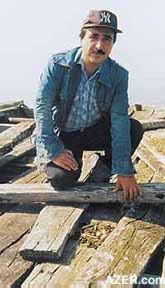  Ornithologists like
Elchin Sultanov have studied the Azerbaijan oil industry's effects
on birds - both positive and negative - and have noticed some
surprising ways that birds have adapted over the years. Old,
unused oil platforms have come to serve an unforeseen purpose
- namely as a safe nesting place for thousands of migrating birds.
Sultanov, who has a Ph.D. in Ornithology, is currently head of
the Ornithological Laboratory of the Academy of Sciences' Zoology
Institute. He also serves as head of Azerbaijan's Center for
the Protection of Birds. Ornithologists like
Elchin Sultanov have studied the Azerbaijan oil industry's effects
on birds - both positive and negative - and have noticed some
surprising ways that birds have adapted over the years. Old,
unused oil platforms have come to serve an unforeseen purpose
- namely as a safe nesting place for thousands of migrating birds.
Sultanov, who has a Ph.D. in Ornithology, is currently head of
the Ornithological Laboratory of the Academy of Sciences' Zoology
Institute. He also serves as head of Azerbaijan's Center for
the Protection of Birds.
Left:
Ornithologist
Elchin Sultanov points out a nest.
_____
Oil has been extracted from the Azerbaijani sector of the Caspian
Sea for more than 50 years. At the same time, this area - the
western coast of the Caspian - is one of the world's most important
passages for migrating birds. Each year, birds fly from Northern
Eurasia (northern Russia, western Siberia, Volga-Urals, Kazakhstan,
part of Fennoscandia) on their way to northern Iran, the Persian
Gulf region, Arabia, Egypt and eastern Africa to stay for the
winter. According to our calculations, about 20 million waterbirds
migrate along the Western coast of the Caspian Sea each year.
Some of the birds that normally make their habitat in Kazakhstan
fly directly across the Caspian. A significant number of these
birds (more than 1.3 million) winter along the Caspian coast
of Azerbaijan and the inner nature reserve. About a half million
of them winter along Lake Sarisu (Yellow Water), and an estimated
100,000 winter at Lake Aghgol (White Lake). Along the coast alone
there are at least 700,000 birds that winter each year, out of
which an estimated 500,000 remain at the Gizilaghaj reserve in
southeast Azerbaijan.
Naturally, these birds are impacted by the development of oil
in the Caspian. In 1996 and 1997, a team of Azerbaijani ornithologists
set out to research the effects of the oil industry on the environment.
This study, which never would have been attempted during Soviet
times, was sponsored by the Azerbaijan International Operating
Company (AIOC).
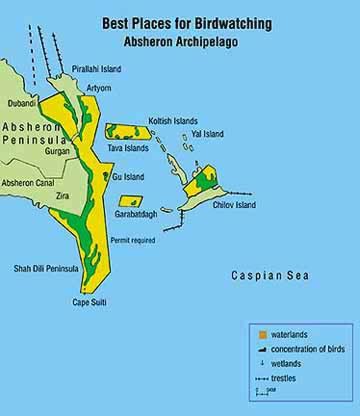  A New Home A New Home
We knew that large groups of birds nested on some of the small
islands offshore Baku and in the Absheron archipelago. But it
came as a big surprise to us to discover large nestings of cormorants,
gulls and terns on the old oil platforms out in the sea. These
abandoned platforms were built during Soviet times and are about
20 x 30 m. Many of the platforms are located 50-60 km northeast
of Baku and about 100 km to the south. After oil was extracted
from the sea and it was no longer possible to get any more, these
platforms were abandoned. They are a problem for ship captains
who have to navigate around them and wish that they would be
disassembled.
Cormorants (Phalacrocorax carbo) usually nest in trees or high
bushes, but the region onshore that is close to the oil wells
is semi-desert without trees. So the birds have begun making
nests on the abandoned oil platforms by bringing twigs from the
land. Nesting so close to the sea is very convenient for cormorants,
since they feed on small fish and can catch them without flying
very far from their nests
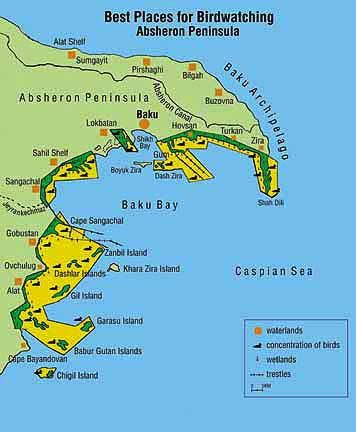  While 50-60 years ago
there were not that many cormorants nesting on Azerbaijan's coast,
today the cormorant is one of the most common birds. It used
to be that they only stayed on the oil platforms for the winter
or while they were passing through. But now they seem to be nesting
permanently there. This leaves us with a dilemma: if we start
to disassemble the old oil platforms, we'll inevitably be displacing
thousands of birds, especially the cormorants. While 50-60 years ago
there were not that many cormorants nesting on Azerbaijan's coast,
today the cormorant is one of the most common birds. It used
to be that they only stayed on the oil platforms for the winter
or while they were passing through. But now they seem to be nesting
permanently there. This leaves us with a dilemma: if we start
to disassemble the old oil platforms, we'll inevitably be displacing
thousands of birds, especially the cormorants.
Another species that is commonly found in the area is the Herring
gull or Yellow-legged gull (Larus argentatus cachinans). Unlike
cormorants, these birds nest only on the ground or at least on
a smooth surface, for example, the roofs of abandoned constructions.
But like cormorants, they also nest on abandoned oil platforms,
right on the old decks.
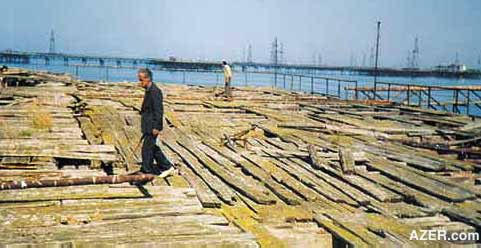
Above:
Looking
for seagull nests amongst a decrepit oil platform in the Caspian.
These waterbirds often have to compete with local residents who
scavenge the wood for use in building shelters.
Seagulls in particular like to nest on the abandoned wooden decks
found at the Bahar oilfield, located 50 km south of Baku. Unlike
cormorants, seagulls can't nest on metal platforms. They have
had to compete with local residents, as people from coastal villages
tend to scavenge wood from the platforms for their houses or
yards - especially the refugees who have had to scrounge around
to find any kind of material that they can use for building shelters,
thus leaving the seagulls without a place to nest.
Rare Species
Other birds such as the Common Tern (Sterna hirundo) prefer to
nest on islands rather than on oil platforms. On Garasu (Black
Water) island, we've detected nestings of a very rare species
called the Sandwich Tern (Sterna sandvicensis). On the Babur-Gutan
island system, we've identified the only nesting place of the
Mediterranean Gull (Larus melanocephala) in Azerbaijan; there
are an estimated 250 mating pairs located there.
Also on these islands are nestings of the beautiful Ruddy Shell
Duck (Tadorna ferruginea), which has European Threatened Status.
This designation, which is assigned by BirdLife International,
a worldwide bird conservation organization, refers to a species
that may be common in other parts of the world, but is rare or
threatened in Europe.
Above: Some of the birds that
use Azerbaijan as a migratory route make their nests on the coastal
marshland waters and in the trestles of abandoned oil platforms.
On Gil (Clay) island of the Baku archipelago, approximately 60
km southwest of Baku, we have also detected nestings by small
waders like the Kentish Plover (Charadrius alexandrinus); the
Colored Pratincol (Glareola pratincola), a bird that catches
insects in the air and resembles a big swallow (it also has European
Threatened Status); the Little Tern (Sterna albifrons), which
has European Threatened Status, and several other species.
With more research, it is possible that we will find even more
rare birds making their homes in Azerbaijan. But unfortunately,
we are not currently carrying out any systematic ornithological
monitoring in connection with oil development. Hopefully in the
future, we will have the chance to learn more about how birds
co-exist with oil development and how we can help protect them
and their natural habitats.
_____
From Azerbaijan
International
(9.2) Summer 2001.
© Azerbaijan International 2001. All rights reserved.
Back to Index
AI 9.2 (Summer 2001)
AI Home
| Magazine Choice | Topics
| Store
| Contact
us
|








